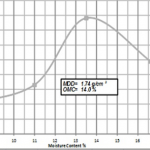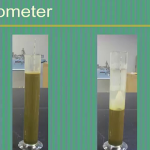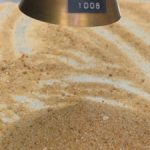Introduction
Specific gravity is the ratio of the density of a substance to the density of a reference substance; equivalently, it is the ratio of the mass of a substance to the mass of a reference substance for the same given volume. Apparent specific gravity is the ratio of the weight of a volume of the substance to the weight of an equal volume of the reference substance. The reference substance is nearly always water at its densest (4°C) for liquids; for gases it is air at room temperature (25°C). Simply put, the specific gravity of a substance determines its behavior in water. If it is less than 1, the substance floats in water, and if greater than 1, the substance sinks. Specific gravity is normally used in mixture proportioning calculations. The specific gravity of portland cement is generally around 3.15 (i.e. 3.5 times heavier than water) while the specific gravity of portland-blast-furnace-slag and portland-pozzolan cements may have specific gravities near 2.90 (i.e. 2.9 times heavier than water)
Why do we need to know the specific gravity of cement before usage?
Normally the specific gravity of Portland cement is 3.15, and the nominal mix design is based on this value. The value will change over time if the cement is exposed to various weather conditions. For example, if the cement has been exposed to extreme moisture content then, the specific gravity of cement will differ because of the moisture content present in the pores. So it is essential to determine the specific gravity of cement before using it. As you may already know, the water cement ratio is an important factor in concrete mixing and construction and t is directly proportional to workability and the strength of a bonding. Thus, if the cement already has more moisture in it, then, the value of water cement ratio will actually affect the workability and strength of the concrete. In a nutshell, the density of the bulk cement (including voids between particles) varies considerably, depending on how it is handled and stored. For example, vibration during transportation of bulk cement consolidates the cement and increases its bulk density. Thus, cement quantities are specified and measured by weight rather than volume.
Objective(s) of the Experiment
The experiment is carried out to determine the value of the specific gravity of cement.
Equipments and Materials Needed
- Ordinary Portland Cement
- Weighing balance with 0.1 gm accuracy
- Le-Chatelier Flask of capacity of 250 ml or Specific Gravity Bottle / Pycnometer ( of 100 ml volume)
- Kerosene
How Come Kerosene is Used when Water was the Material Mentioned in the Introduction?
Normally, for the determination of specific gravity of any material, water is the best material to use. However, when water is added to cement, a compound is formed (carbon oxide), while kerosene and cement do not react together. This amendment is later catered for as you will see in the calculation by a factor of 0.79, which is the specific gravity of kerosene.
Procedures
- Wash and completely dry the flask, then weigh it. Record the Weight of Empty Flask = W1
- Pour the cement up to half of the flask (about 50gm) and weigh. Record the Weight of Flask and Cement= W2
- Add Kerosene to the cement up to the top of the flask. Mix well to remove the air bubbles in it and weigh. Record the Weight of Flask with Cement and Kerosene to Fill = W3.
- Empty the flask, wash properly and dry it. Fill the bottle with kerosene up to the top and weigh. Record the Weight of Flask with Kerosene to Fill= W4
Results and Calculations
The following relation is used to calculate the specific gravity of the cement:

Where the specific gravity of kerosene = 0.79g/cc
Notes:
- The error value will be acceptable within ±0.01.
- The practical will be done within 30°C temperature.
Discussion and Conclusion
Depending on your value, you can know the quality of your cement. If the specific gravity of cement is greater than 3.19 then, the cement was either not pulverized finely as per the industry standard or it has more moisture content which will affect the mix and bonding. This is why you find lots of chunks while mixing old stock cement for concrete.
References
- Wikipedia. “Specific Gravity”. http://en.wikipedia.org/wiki/Specific_gravity. Assessed December 20, 2017.
- CivilBlog.com “Specific Gravity of Cement Determination”. http://www.civilorg.com/Specific_Gravity_of_Cement_Determination.
- Mamlouk, M.S. And Zaniewski J.P. (2011). “Materials For Civil and Construction Engineers”
Download “Specific Gravity Determination of Cement”
Determination-of-Specific-Gravity-of-Cement-1.docx – Downloaded 0 times – 22.84 KB






